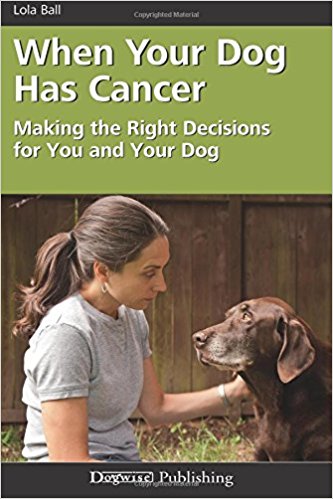Making the Right Decisions for You and Your Dog
by Lola Ball
Lola Ball was inspired to write about her experiences after two of her dogs developed cancer. Porter, a lab, had hemangiosarcoma and Jasper, a lab mix had mast-cell tumors on his liver. Ball interweaves her dog’s stories in with detailed information about treating dogs with cancer. She has consulted with veterinarians and referenced many books on the topic. But mostly, she tells her story and the experiences of others. I felt the stories were the heart of this book.
The author’s goal in When Your Dog Has Cancer was to provide information not included in other books on dogs with cancer, most of which were written by veterinarians. Her book provides many websites, hot lines, and references.
Some of the key points include:
-
- Hospice care – a topic not often covered in other books, or at least not in detail. She discusses how to get your dog to eat, to sleep comfortably, to reduce pain, when to euthanize, and the grieving process.
This post contains an Amazon affiliate links. If you click on the book above and make a purchase, even on a different item, then I will earn a small compensation. Thank you!
- Diagnosis—when your pet first doesn’t seem right, or you find a lump, should you visit the vet? Ball discusses what tests are necessary and what they mean. She gives many good pointers such as…
- bringing a notepad when your vet reviews the test results and discusses options. There are many options and cost ranges, and months or years of potential life expectancies, so you will want to take notes or have a friend with you who can listen objectively. Often we are so overwrought when we hear the words “cancer,” that much of the detailed information may be forgotten.
- making a list of questions to ask your vet. I found this very helpful, since I have often thought of many of these questions when it was too late to ask.
- research the disease and treatment options.
- determine your capabilities, both financially and time wise. Ask your friends and neighbors about their experiences.
- determine the dog’s current health. How will some of these treatments affect him and how much longer might he live? Remember to do treatments based on what is best for your dog, which may not necessarily be the best option for you.
- Assemble a team—you may want to include an oncologist and a holistic vet in addition to your veterinarian.
- Treatment plans—Ball briefly discusses the big three treatments for cancer, surgery, chemotherapy, and radiation. The author also covers diet and holistic therapies and includes new treatments such as immunotherapy, photodynamic and antiangiogenic therapies. Other methods included cryosurgery, hyperthermia, traditional Chinese medicine (TCM), and supplements.
- Ball provides a table showing the pros and cons of each treatment, which I thought was invaluable. Some of these treatments may not be available in all areas. Sometimes a holistic veterinarian can provide these treatments.
- Know your dog—by keeping a journal of what your dog eats, how he feels, any medications or treatments that were given. This will help you and your veterinarian to determine the success of each procedure and its side effects.
Decisions about treatment plans.
Many vets do not discuss the amount of time you will need to invest in your dog’s treatment, such as the number of vet visits and the costs. These important points may influence your decisions regarding treatments and hospice care. I remember having no idea of the number of treatments and cost when I started physical therapy with my dog that had osteosarcoma.
Learn to identify when your dog is in pain. Often our dogs try to hide their pain and we don’t realize how bad they feel—so knowing what to look for helps. Ball discusses many types of pain management.
The author provides a thorough discussion on healthy diets and even home-cooked recipes. She includes information on cancer-fighting herbs and supplements, the need for exercise, reducing stress, quality of sleep, massage techniques, as well as grooming needs. Ball stresses keeping a positive outlook so our dog’s respond to our emotions.
Prevention, Death, and Stories
With such a high percentage of our senior pets developing cancer, preventative measures can help. Many of these steps involve limiting exposure to chemicals, such as lawn pesticides (which we have always been told is safe once it dries), as well as household chemicals.
Ball also describes the four stages of the dying process, some of which may occur weeks ahead of time, others only moments before the end. A list of websites and books can help the reader understand this process in more detail.
The best part about this book is the stories it tells of various dogs. Not all of these ended in death—a real plus!
I rate When Your Dog Has Cancer a 5 out of 5 stars.

